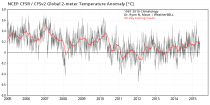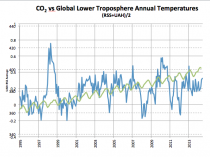By Joseph D’Aleo, CCM
Last month was the hottest June since record keeping began in 1880, the US National Oceanic and Atmospheric Administration (NOAA) said Monday. It marked the third month in a row that global temperature reached a record high. According to the NOAA data, April and May were also global record-breakers. The combined average temperature over global land and ocean surfaces for June 2014 was record high for the month at 16.22 degrees Celsius, or 0.72 degree Celsius above the 20th century average of 15.5 degrees Celsius,’ the NOAA said in its monthly climate report. “This surpasses the previous record, set in 2010, by 0.03 degrees Celsius.”
Nine of the ten hottest Junes on record have all occurred during the 21st century, including each of the past five years, the U.S. agency said.
However as we have shown here, the warming is all in the questionable adjustments made to the data, with a major cooling of the past and allowance for UHI contamination in recent decades. The all time record highs and days over 90F tell us we have been in a cyclical pattern with 1930s as the warmest decade.
NOAA and NASA (which uses data gathered by NOAA climate center in Asheville) has been commissioned to participate in special climate assessments to support the idealogical and political agenda of the government. From Fiscal Year (FY) 1993 to FY 2013 total US expenditures on climate change amounted to more than $165 Billion. More than $35 Billion is identified as climate science. The White House reported that in FY 2013 the US spent $22.5 Billion on climate change. About $2 Billion went to US Global Change Research Program (USGCRP). The principal function of the USGCRP is to provide to Congress a National Climate Assessment (NCA). The latest report uses global climate models, which are not validated, therefor speculative, to speculate about regional influences from global warming. (SEPP)
The National Climate Data Center and NASA climate group also control the data that is used to verify these models which is like putting the fox in charge of the hen house. At the very least, their decisions and adjustments may be because they really believe in their models and work to find the warming they show - a form of confirmation bias.
Please note: This is not an indictment of all of NOAA where NWS forecasters do a yeoman’s job providing forecasts and warnings for public safety.
NCEP gathers real time data that is used to run the models. When we take the initial analyses that go into the models and compute monthly anomalies, we get very small departures from normal for the 1981 to 2010 base period on a monthly or year to date basis.
The satellite data from RSS and UAH only available since 1979 also shows no warming for over a decade (two in the RSS data). It needs no adjustments that NOAA claims are required for station and ocean data.
This government manipulation of data may be simply a follow up to the successful manipulation of other government data that has largely escaped heavy public scrutiny.
Over the last 12 months, the CPI has increased 2.1%. Real inflation, using the reporting methodologies in place before 1980, hit an annual rate of 9.6 percent in February, according to the Shadow Government Statistics newsletter. The BLS U6 measure, the total unemployed, plus all persons marginally attached to the labor force, plus total employed part time for economic reasons, as a percent of the civilian labor force plus all persons marginally attached to the labor force is 12.1%.
CPI is used to adjust social security benefits and military pay and to a large degree as one factor in industry wages. if you are feeling you are falling behind, it is because the real costs of goods and services have risen more than any income or benefits you receive. That is why the GDP actually fell early this year - between the high cost of energy and food, the discretionary income for spending retail and in restaurants fell.
Unemployment fell to 6.1% according to the government but the real unemployment is much higher. Using the employment-population ratio, the percentage of working age Americans that actually have a job has been below 59 percent for more than four years in a row. That means that more than 41 percent of all working age Americans do not have a job.
The sad news is if NOAA keeps providing the government with tainted data to justify its EPA assault on our country’s only reliable energy sources, inflation will skyrocket and unemployment will follow.
Larry Bell
It seems that even wood isn’t green or renewable enough anymore. The EPA has recently banned the production and sale of 80% of America’s current wood-burning stoves, the oldest heating method known to mankind and mainstay of rural homes and many of our nation’s poorest residents. The agency’s stringent one-size-fits-all rules apply equally to heavily air-polluted cities and far cleaner plus typically colder off-grid wilderness areas such as large regions of Alaska and the American West.
While the EPA’s most recent regulations aren’t altogether new, their impacts will nonetheless be severe. Whereas restrictions had previously banned wood-burning stoves that didn’t limit fine airborne particulate emissions to 15 micrograms per cubic meter (μg/m3) of air, the change will impose a maximum 12 μg/m3 limit. To put this amount in context, the EPA estimates that secondhand tobacco smoke in a closed car can expose a person to 3,000-4,000 μg/m3 of particulates.
Most wood stoves that warm cabin and home residents from coast to coast cannot meet that standard. Older stoves that don’t cannot be traded in for updated types, but instead must be rendered inoperable, destroyed, or recycled as scrap metal.
The impacts of the EPA ruling will affect many families. According to the U.S. Census Bureau’s 2011 survey statistics, 2.4 million American housing units (12% of all homes) burned wood as their primary heating fuel, compared with 7% that depended upon fuel oil.
Local governments in some states have gone even further than the EPA, banning not only the sale of noncompliant stoves, but even their use as fireplaces. As a result, owners face fines for infractions. Puget Sound, Washington, is one such location. Montreal, Canada, proposes to eliminate all fireplaces within its city limits.
Only weeks after the EPA enacted its new stove rules, attorneys general of seven states sued the agency to crack down on wood-burning water heaters as well. The lawsuit was filed by Connecticut, Maryland, Massachusetts, New York, Oregon, Rhode Island, and Vermont, all predominantly Democrat states. Claiming that the new EPA regulations didn’t go far enough to decrease particle pollution levels, the plaintiffs cited agency estimates that outdoor wood boilers will produce more than 20% of wood-burning emissions by 2017. A related suit was filed by the environmental group EarthJustice.
Did EPA require a motivational incentive to tighten its restrictions? Sure, about as much as Br’er Rabbit needed to persuade Br’er Fox to throw him into the briar patch. This is but another example of EPA and other government agencies working with activist environmental groups to sue and settle on claims that afford leverage to enact new regulations which they lack statutory authority to otherwise accomplish.
“Sue and Settle” practices, sometimes referred to as “friendly lawsuits,” are cozy deals through which far-left radical environmental groups file lawsuits against federal agencies wherein court-ordered “consent decrees” are issued based upon a prearranged settlement agreement they collaboratively craft together in advance behind closed doors. Then, rather than allowing the entire process to play out, the agency being sued settles the lawsuit by agreeing to move forward with the requested action both they and the litigants want.
And who pays for this litigation? All too often we taxpayers are put on the hook for legal fees of both colluding parties. According to a 2011 GAO report, this amounted to millions of dollars awarded to environmental organizations for EPA litigations between 1995 and 2010. Three “Big Green” groups received 41% of this payback, with Earthjustice accounting for 30% ($4,655,425). Two other organizations with histories of lobbying for regulations EPA wants while also receiving agency fundIng are the American Lung Association (ALA) and the Sierra Club.
In addition, the Department of Justice forked over at least $43 million of our money defending the EPA in court between 1998 and 2010. This didn’t include money spent by the EPA for its legal costs in connection with those ripoffs, because the EPA doesn’t keep track of its attorneys’ time on a case-by-case basis.
The U.S. Chamber of Commerce has concluded that Sue and Settle rulemaking is responsible for many of EPA’s “most controversial, economically significant regulations that have plagued the business community for the past few years.” Included are regulations on power plants, refineries, mining operations, cement plants, chemical manufacturers, and a host of other industries. Such consent decree-based rulemaking enables EPA to argue to Congress: “The court made us do it.”
Directing special attention to these congressional end run practices, Louisiana Senator David Vitter, top Republican on the Senate Environment and Public Works Committee, has launched an investigation. Last year he asked his Louisiana Attorney General Buddy Caldwell to join with AG’s of 13 other states who filed a Freedom of Information Act (FOIA) seeking all correspondence between EPA and a list of 80 environmental, labor union, and public interest organizations that have been party to litigation since the start of the Obama Administration.
Other concerned and impacted parties have little influence over such court procedures and decisions. While the environmental group is given a seat at the table, outsiders who are most impacted are excluded, with no opportunity to object to the settlements. No public notice about the settlement is released until the agreement is filed in court...after the damage has been done.
In a letter to Caldwell, Senator Vitter wrote: “The collusion between federal bureaucrats and the organizations entering consent agreements under a shroud of secrecy represents the antithesis of a transparent government, and your participation in the FOIA request will help Louisianans understand the process by which these settlements were reached.”
Fewer citizens would challenge the EPA’s regulatory determinations were it not for its lack of accountability and transparency in accomplishing through a renegade pattern of actions what they cannot achieve through democratic legislative processes.
A recent example sets unachievable CO2 emission limits for new power plants. As I reported in my January 14 column, a group within the EPA’s own Science Advisory Board (SAB) determined that the studies upon which that regulation was based had never been responsibly peer reviewed, and that there was no evidence that those limits can be accomplished using available technology.
Compared with huge consequences of the EPA’s regulatory war on coal, the fuel source that provides more than 40% of America’s electricity, a clamp-down on humble residential wood-burning stoves and future water heaters may seem to many people as a merely a trifling or inconsequential matter. That is, unless it happens to significantly affect your personal life.
As a Washington Times editorial emphasized, the ban is of great concern to many families in cold remote off-grid locations. It noted, for example, that “Alaska’s 663,000 square miles is mostly forestland, offering residents and abundant source of affordable firewood. When county officials floated a plan to regulate the burning of wood, residents were understandably inflamed.”
Quoting Representative Tammie Wilson speaking to the Associated Press, the Times reported: “Everyone wants clean air. We just want to make sure that we can also heat our homes.” Wilson continued: “Rather than fret over the EPA’s computer-model-based warning about the dangers of inhaling soot from wood smoke, residents have more pressing concerns on their minds as the immediate risk of freezing when the mercury plunges.”
And speaking of theoretical computer model-based warnings, where’s that global warming when we really need it?
See more HERE.
--------
Jay Lehr, Ph.D., science director for the Heartland Institute, and one of the nation’s most respected and widely cited experts on air and water quality, climate change, and biotechnology, broke ground in revealing his comprehensive plan to reform the EPA in his remarks as a Keynote breakfast speaker at Heartland’s recent International Conference on Climate Change held in Las Vegas from July 7- 9. Jay Lehr, Ph.D. introduced a legislative plan to replace the United States Environmental Protection Agency with a Committee of the Whole of the State Environmental Protection Agencies, utilizing a phased five-year transition period. See the detailed plan here.
Broadcast live streaming video on Ustream
Voters strongly believe the debate about global warming is not over yet and reject the decision by some news organizations to ban comments from those who deny that global warming is a problem.
Only 20% of Likely U.S. Voters believe the scientific debate about global warming is over, according to the latest Rasmussen Reports national telephone survey. Sixty-three percent (63%) disagree and say the debate about global warming is not over. Seventeen percent (17%) are not sure. (To see survey question wording, click here.)
Forty-eight percent (48%) of voters think there is still significant disagreement within the scientific community over global warming, while 35% believe scientists generally agree on the subject.
The BBC has announced a new policy banning comments from those who deny global warming, a policy already practiced by the Los Angeles Times and several other media organizations. But 60% of voters oppose the decision by some news organizations to ban global warming skeptics. Only 19% favor such a ban, while slightly more (21%) are undecided.
But then 42% believe the media already makes global warming appear to be worse than it really is. Twenty percent (20%) say the media makes global warming appear better than it really is, while 22% say they present an accurate picture. Sixteen percent (16%) are not sure.
Still, this is an improvement from February 2009 when 54% thought the media makes global warming appear worse than it is. Unchanged, however, are the 21% who say the media presents an accurate picture.
The survey of 1,000 Likely Voters was conducted on July 7-8, 2014 by Rasmussen Reports. The margin of sampling error is +/- 3 percentage points with a 95% level of confidence. Field work for all Rasmussen Reports surveys is conducted by Pulse Opinion Research, LLC. See methodology.
Consistent with earlier polling is the finding that 60% of voters consider global warming a serious problem, with 37% who describe it as a Very Serious one. Thirty-five percent (35%) disagree and don’t believe global warming is that serious a problem, with 14% who say it is Not At All Serious.
But even among those voters who consider global warming a Very Serious problem, 57% say the debate is not yet over. These voters by a 49% to 34% margin also oppose the decision by some news organizations to ban global warming skeptics.
The older the voter, generally speaking, the more likely they are to believe that the debate about global warming is not over.
Most voters across all demographic categories say the debate is not over. Most also oppose the decision by some media outlets to ban global warming critics.
Men and those over 40 are more skeptical of the media’s coverage of global warming than women and younger voters are.
Sixty-four percent (64%) of Republicans and a plurality (45%) of voters not affiliated with either major political party believe the media makes global warming appear to be worse than it really is. Just 22% of Democrats agree. But Democrats also believe much more strongly than the others that global warming is a serious problem.
Twenty-seven percent (27%) of voters in President Obama’s party think the scientific debate about global warming is over, a view shared by only 12% of GOP voters and 16% of unaffiliateds.
Sixty-seven percent (67%) of all voters say they have been following recent news reports about global warming at least somewhat closely, with 33% who are following Very Closely.
Because congressional Republicans oppose most of the initiatives he has proposed, the president has signaled that he is prepared to take whatever actions he can alone to deal with a problem he attributes largely to certain human activities. However, just 30% of voters think the president should take action alone if necessary to deal with global warming. Twice as many (59%) say the federal government should only do what the president and Congress jointly agree on.
While most voters have expressed concern about global warming for years, only 41% are willing to pay more in taxes or in utility costs to generate cleaner energy and fight global warming. That includes 23% who are willing to pay no more than $100 extra a year.
-------
Meanwhile the NRDC tells skeptics to give it up here. The NYT told how the most heavily funded econazi group in the NRDC and they not surprisingly claim they provided the blueprint for the deadly Obama Climate Action Plan.
Since its founding in 1970, the Natural Resources Defense Council has not sought the public profile of activist organizations like Greenpeace, but it has piled up a string of substantial legal and policy victories.
Its annual budget of about $120 million is far higher than that of most environmental groups, in part because of board members like Mr. DiCaprio and Mr. Redford, who are the attractions at lavish fund-raising galas for studio heads and Silicon Valley magnates. In a typical event in 2011, guests at the Malibu home of Ron Meyer, now the vice chairman of NBCUniversal, sipped Champagne and watched surfers paddle out to form a peace sign in the Pacific Ocean. The event raised $2.6 million.
The council’s fund-raising office in New York has also found big donors in the business world, including at Google and Goldman Sachs.
Sorry NRDC America we will continue to fight your activism and lies and the EPA which announced onerous plans to heavily fine you (say $70k) garnish your wages without court approval for anything you may do YOUR property that an EPA appointed bureaucrat finds is not acceptable to him/her. This might include putting in a pond on your land, perhaps removing a stand of trees, etc.
Newsbusters reports the liberal media is unwilling to make the George Soros/NRDC connection.
The liberal media love to hate the Koch Brothers but are far less enthusiastic about connecting George Soros’ billions to liberal policies.
On July 6, Coral Davenport of The New York Times revealed that the Environmental Protection Agency’s (EPA) new regulations on power plant emissions were largely inspired by the work of environmental activists at the Natural Resources Defense Council (NRDC). The broadcast networks have not mentioned the NRDC connection to the new regulations, and even the Times ignored that liberal mega-donor Soros has bankrolled the NRDC.
The Times called the EPA regulations “a remarkable victory for the National Resources Defense Council” for developing the “novel” framework that the EPA would adopt, but they also failed to mention the more than $1.7 million in Soros-funding the group received since 2004 ($1,771,893).
On June 1, the EPA unveiled drastic limits on carbon emissions, mandating steep emission cuts within 16 years. While emission limits weren’t a new idea, the EPA plan “sets different limits for each state and allows states the flexibility to meet the standards by picking from a menu of policy options,” according to Davenport.
Davenport traced this innovation back to a specific 110-page proposal, written by two lawyers, David Doniger and David Hawkins, and energy policy expert, Daniel Lashof. All three individuals work with the NRDC, though Lashof only advises the organization since he joined left-wing billionaire donor Tom Steyer’s Next Gen Climate America in March. In February, Steyer pledged $100 million to pressure politicians on climate issues.
Few media outlets covered the Times’ revelations about NRDCís involvement. None of the broadcast news programs brought it up. In fact, ABC, CBS and NBC news programs have ignored the EPA regulations since June 2.
Print media was not much better. While the Daily Mail (UK) reported on Davenport’s findings, few other news outlets joined in. The Hill and the National Journal both published brief pieces on EPA officialís response denying that the NRDC had any remarkable influence. None of that coverage brought up Soros’ donations to the NRDC.
Of course, both the networks and print media have been incredibly biased while pushing the EPA’s regulations. While discussing the plan, which CBS called “groundbreaking,” on June 2, 85 percent of the coverage completely ignored the economic impact. Additionally, an examination of major U.S. newspapers found that 90 percent of their editorial pages supported or ignored the EPA’s scheme.



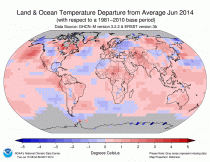
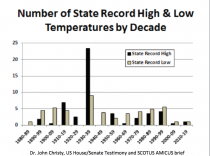

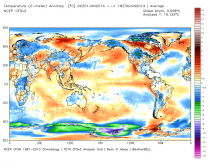
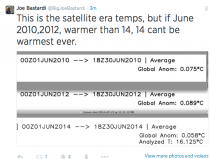
_thumb.png)
